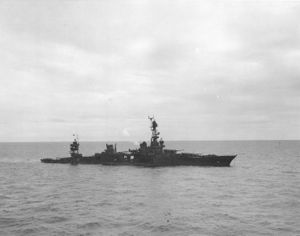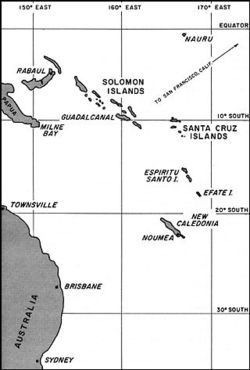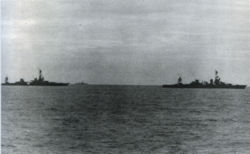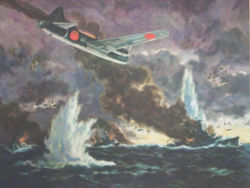Battle of Rennell Island
2007 Schools Wikipedia Selection. Related subjects: World War II
| Battle of Rennell Island | |||||||
|---|---|---|---|---|---|---|---|
| Part of the Pacific Theatre of World War II | |||||||
 USS Chicago low in the water on the morning of January 30, 1943 due to torpedo damage inflicted the night before. |
|||||||
|
|||||||
| Combatants | |||||||
| United States Australia |
Japan | ||||||
| Commanders | |||||||
| William Halsey, Jr., Robert C. Giffen |
Isoroku Yamamoto, Junichi Kusaka |
||||||
| Strength | |||||||
| 1 fleet carrier, 2 escort carriers, 6 cruisers, 8 destroyers, 14 fighter aircraft |
32 bomber aircraft | ||||||
| Casualties | |||||||
| 1 cruiser sunk, 1 destroyer heavily damaged, 85 killed |
12 aircraft destroyed, 60–84 killed |
||||||
| Guadalcanal campaign |
|---|
| Tulagi – Savo I. – Tenaru – Eastern Solomons – Edson's Ridge – Cape Esperance – Henderson Field – Santa Cruz Is. – Naval Guadalcanal – Tassafaronga – Ke – Rennell I. |
| Solomon Islands campaign |
|---|
| 1st Tulagi – Guadalcanal – Blackett Strait – Cartwheel – Death of Yamamoto – New Georgia – Kula Gulf – Kolombangara – Vella Gulf – Horaniu – Vella Lavella – Naval Vella Lavella – Treasury Is. – Choiseul – Empress Augusta Bay – Cape St. George – Green Is. – 2nd Rabaul – Bougainville |
The Battle of Rennell Island (Japanese: レンネル島沖海戦) took place on January 29–30, 1943, and was the last major naval engagement between the United States Navy and the Imperial Japanese Navy during the lengthy Battle of Guadalcanal in the Solomon Islands campaign during World War II. The battle took place in the South Pacific between Rennell Island and Guadalcanal in the southern Solomon Islands.
In the battle, Japanese naval land-based torpedo bombers, seeking to provide protection for the impending evacuation of Japanese forces from Guadalcanal, made several attacks over two days on United States' (U.S.) warships operating as a task force south of Guadalcanal. In addition to approaching Guadalcanal with the objective of engaging any Japanese ships that might come into range, the U.S. task force was protecting an Allied transport ship convoy that was carrying replacement troops to Guadalcanal. As a result of the Japanese air attacks on the task force, one U.S. heavy cruiser was sunk, a destroyer was heavily damaged, and the rest of the U.S. task force was forced to retreat from the southern Solomons area. Due, in part, to their success in turning back the U.S. task force in this battle, the Japanese were successful in evacuating their remaining troops from Guadalcanal by February 7, 1943, leaving Guadalcanal in Allied hands and ending the battle for the island.
Background
On August 7, 1942, Allied forces (primarily U.S.) landed on Guadalcanal, Tulagi, and Florida Islands in the Solomon Islands. The landings on the islands were meant to deny their use by the Japanese as bases to threaten the supply routes between the U.S. and Australia, and to use them as starting points for a campaign with the eventual goal of isolating the major Japanese base at Rabaul while also supporting the Allied New Guinea and New Britain campaigns. The landings initiated the six-month-long Battle of Guadalcanal.
The last major attempt by the Japanese to drive Allied forces from Guadalcanal and Tulagi was defeated during the decisive Naval Battle of Guadalcanal in early November, 1942. Thereafter, the Japanese Navy was only able to deliver subsistence supplies and a few replacement troops to Japanese Army forces on Guadalcanal. Due to the threat from Allied aircraft based at Henderson Field on Guadalcanal, plus nearby U.S. aircraft carriers, the Japanese delivered these supplies at night, usually by destroyer or submarine, in operations the Allies called the " Tokyo Express." However, these supplies and replacements weren't enough to sustain Japanese troops on the island, who, by December 7, 1942, were losing about 50 men each day from malnutrition, disease, and Allied ground or air attacks. On December 12, the Japanese Navy proposed that Guadalcanal be abandoned. In spite of opposition from Japanese Army leaders, who still hoped that Guadalcanal could eventually be retaken from the Allies, Japan's Imperial General Headquarters, with approval from the Japanese Emperor, on December 31, 1942, agreed to the evacuation of all Japanese forces from the island and establishment of a new line of defense for the Solomons on New Georgia.

The Japanese titled the evacuation effort of their forces from Guadalcanal Operation Ke (ケ号作戦) and planned to execute the operation beginning January 14, 1943. An important element in the operation's plan was an air superiority campaign set to begin on January 28, with the objective of inhibiting Allied aircraft or warships from disrupting the final stage of the Ke operation, which was the actual evacuation of all Japanese troops from Guadalcanal.
Allied forces misinterpreted the Ke preparations as the beginning of another Japanese offensive to try to retake Guadalcanal. At this same time, Admiral William Halsey, Jr., overall commander of Allied forces involved in the battle for Guadalcanal, was under pressure from his superiors to complete the replacement of the U.S. 2nd Marine Division on Guadalcanal, which had been involved in the fighting since the initial landings in August, with fresh U.S. Army troops. Halsey hoped to take advantage of what he believed was an impending Japanese offensive to draw Japanese naval forces into a battle, while at the same time delivering the replacement army troops to Guadalcanal. Therefore, Halsey prepared and sent, on January 29, 1943, towards the southern Solomons area five warship task forces to cover the relief convoy and to engage any Japanese naval forces that came into range. These five task forces included two fleet carriers, two escort carriers, three battleships, 12 cruisers, and 25 destroyers.
In front of this array of task forces was the troop convoy (Task Group (TG) 62.8), consisting of four transports and four destroyers. Ahead of the troop convoy, between Rennell Island and Guadalcanal, was a close support group called Task Force 18 (TF 18), under Rear Admiral Robert C. Giffen, which consisted of heavy cruisers Wichita, Chicago, and Louisville, light cruisers Montpelier, Cleveland, and Columbia, escort carriers Chenango and Suwanne, and eight destroyers. Admiral Giffen commanded TF 18 from Wichita. A fleet carrier task force, centered on U.S. carrier Enterprise, steamed about 250 miles behind TG 62.8 and TF 18. The other fleet carrier and battleship task forces were about 150 miles further back. Admiral Griffen, along with cruiser Wichita and the two escort carriers, had just arrived in the Pacific after participating in Operation Torch in the North African Campaign. Also, Chicago had just arrived back in the South Pacific, after completing repairs from damage suffered during the Battle of Savo Island, almost six-months before.
Battle
Prelude
In addition to protecting the troop convoy, TF 18 was charged with rendezvousing with a force of four U.S. destroyers, stationed at Tulagi, at 21:00 on January 29 in order to conduct a sweep up " The Slot" north of Guadalcanal the next day to screen the unloading of the troop transports at Guadalcanal. However, the escort carriers were too slow (18 knots) to allow Giffen's force to make the scheduled rendezvous, so Giffen left the carriers behind with two destroyers at 14:00 and pushed on ahead at 24 knots (44 km/h). Wary of the threat from Japanese submarines, which Allied intelligence indicated were likely in the area, Giffen arranged his cruisers and destroyers for anti-submarine defense, not expecting an air attack. The cruisers were aligned in two columns, spaced 2,500 yards apart. Wichita, Chicago, and Louisville, in that order, to starboard and Montpelier, Cleveland, and Columbia to port. The six destroyers were spread along a semicircle 2 miles ahead of the cruiser columns.
Giffen's force was being tracked by Japanese submarines, who reported on Giffen's location and movement to their naval headquarter's units. Around mid-afternoon, based on the submarine's reports, 32 G4M "Betty" torpedo bombers stationed at Munda and Buka airfields in the Solomons, and probably, Rabaul, took-off carrying torpedoes to attack Giffen's force. One Betty turned-back with engine trouble, leaving 31 Betty's in the attack force.
Action on January 29
At sunset, as TF 18 headed northwest 50 miles north of Rennell Island and 100 miles south of Guadalcanal, several of Giffen's ships detected unidentified aircraft on radar 60 miles west of their formation. Having previously insisted on absolute radio silence, Giffen gave no orders about what to do about the unidentified contacts, or any orders at all, for that matter. With the setting of the sun, TF 18's combat air patrol ( CAP) from the two escort carriers returned to their ships for the night, leaving Giffen's ships without air cover.
The radar contacts were, in fact, the approaching 31 Japanese Betty torpedo bombers, who circled around to the south of TF 18 so that they could attack from the east, with the black backdrop of the eastern sky behind them. The Bettys split into two groups, with the first group of 16 bombers commencing their attacks on TF 18 at 19:19. In this attack, all of the first group of Betty's torpedoes missed and one of the bombers was shot down by anti-aircraft fire from Giffen's ships.
Believing the attack was over, Giffen ordered his ships to cease zigzagging and to continue heading towards Guadalcanal on the same course and at the same speed. Meanwhile, other Japanese aircraft began dropping flares and floatlights to mark the course and speed of TF 18 in order to assist with the impending attack by the second group of Bettys.
At 19:38, the second group of Bettys attacked, planting two torpedoes in Chicago, causing heavy damage, and bringing the cruiser to a dead stop. One other torpedo hit Wichita, but didn't explode, and two of the Bettys were shot down by anti-aircraft fire. At 20:08, Giffen ordered his ships to reverse direction, to slow to 15 knots, and to cease firing their anti-aircraft guns, which succeeded in concealing his ships from the Japanese aircraft, who all departed the area by 23:35. In pitch darkness, Louisville managed to take the crippled Chicago under tow and slowly headed south, away from the battle area, escorted by the rest of TF 18.
Action on January 30
Halsey immediately took steps to try to protect the damaged Chicago, notifying the escort carriers to make sure they had a CAP in place at first light, ordering the Enterprise task force to approach and augment the escort carrier's CAP, and sending the fleet tug Navajo to take over the tow from Louisville, which was accomplished at 08:00. Between daybreak and 14:00, numerous Japanese scout aircraft approached TF 18. Although they were all chased away by the CAP, they were able to observe and report the position of Chicago. At 12:15, a force of 11 Bettys launched to attack the damaged U.S. cruiser. The U.S. ships knew the Bettys were coming, due to a warning report from an Australian coastwatcher in the Solomon Islands, with an estimated arrival time of 16:00. However, Halsey ordered the rest of the cruisers to leave Chicago behind and head for port at Efate, in the New Hebrides, which they did at 15:00, leaving behind six destroyers to protect Chicago and Navajo.
At 15:40, Enterprise was 43 miles away from Chicago, with ten of her fighters forming a CAP over the damaged cruiser. At this time, four of the CAP fighters chased and shot-down a scout Betty bomber. At 15:54, radar on Enterprise detected the incoming flight of Bettys, and launched 10 more fighters to attack the Betty formation. The escort carriers, however, had difficulties in getting their aircraft launched, preventing them from joining in the attack on the Betty formation until the engagement was over.
At first the Bettys appeared to be trying to approach and attack Enterprise, but, turned towards Chicago after six Enterprise CAP fighters began to engage them. Four other CAP fighters chased the Bettys as they entered the anti-aircraft fire from Chicago's escorting destroyers. In all, eight of the attacking Bettys were shot down by the CAP fighters or by anti-aircraft fire, but most of the bombers were able to drop their torpedoes before crashing.
One torpedo hit U.S. destroyer La Vallette in her forward engine room, killing 22 of her crew and causing heavy damage. Chicago was hit by four torpedoes, one forward of the bridge and three others in her engineering spaces. Chicago's captain, Ralph O. Davis, ordered the ship to be abandoned, and the cruiser sank, stern first, 20 minutes later. Navajo and the escorting destroyers rescued 1,049 survivors from Chicago's crew, but 62 of her crew "joined Chicago in death." A final attack force of Japanese Betty torpedo bombers failed to find the remaining U.S. ships. Navajo took La Vallette under tow, and all of the remaining ships of TF 18 were able to make it to port at Espiritu Santo without further incident.
Aftermath
The Japanese widely publicized the results of the engagement, claiming to have sunk a "battleship" and "three cruisers." The U.S., on the other hand, tried to conceal the loss of Chicago from the public for some time, with Admiral Chester Nimitz, commander in chief of Allied Pacific forces, threatening to "shoot" any of his staff who leaked the loss of Chicago to the press. Halsey and Nimitz blamed Giffen for the defeat and stated so in Giffen's official performance report for the period. The defeat and resulting recriminations do not appear to have affected Giffen's career too adversely; he continued to lead Allied battleship and cruiser task forces in the Pacific until 1944, and was later promoted to vice admiral.
With Japanese air assets tied-up in the battle with TF 18, the Allied transports were able to complete their mission of replacing the 2nd Marine division on Guadalcanal over the last two days in January. During this time, the other Allied task forces, including the two fleet carrier task forces, took station in the Coral Sea, in anticipation of an expected Japanese offensive in the southern Solomons
In reality, however, the Japanese were completing the secret evacuation of their remaining forces from Guadalcanal over three nights between February 2nd and 7th, 1943. With TF 18 forced to retreat, very few Allied naval forces were left in the immediate Guadalcanal area, allowing the Japanese to successfully retrieve all of their ground forces from under the "noses" of Allied forces, who weren't aware that the Japanese evacuation was happening until it was over. These evacuated ground forces would play an important part in future battles between the Japanese and the Allies in the critical Solomon Islands campaign.




